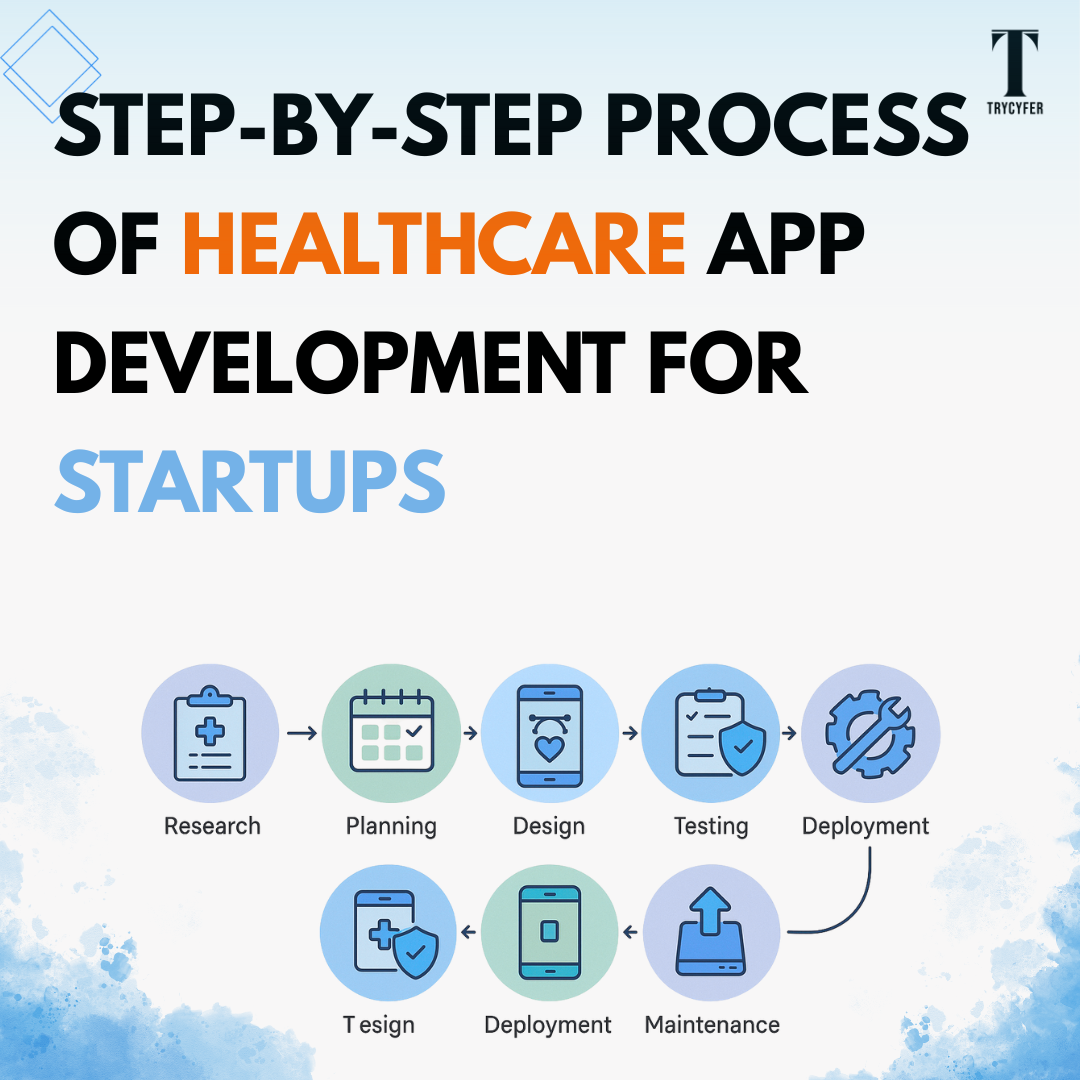Step-by-Step Process of Healthcare App Development for Startups

The journey of healthcare app development for startups is both exciting and challenging. With the growing demand for digital health solutions, startups have the opportunity to make a real impact—but success depends on following a structured, strategic process. Here’s a comprehensive, step-by-step guide tailored for startups aiming to build a robust, secure, and user-friendly healthcare app.
1. Define Your App’s Goals and Conduct Market Research
Start by clarifying the purpose of your healthcare app. Identify the specific problems you want to solve and who your target users are—patients, doctors, clinics, or hospitals. Conduct thorough market research to analyze competitors, understand user pain points, and discover market gaps. Interview potential users and healthcare professionals to validate your app idea and ensure it addresses real needs. Study regulatory requirements relevant to your target region, such as HIPAA, GDPR, or local health data laws, to ensure compliance from the very beginning.
2. Choose the Type of Healthcare App
Decide what kind of healthcare app you want to develop. Options include telemedicine, remote patient monitoring, fitness and wellness, EHR/EMR management, appointment scheduling, or hospital administration. The app type will influence your feature set, design, and technical requirements. Align the app’s focus with your business goals and the unique needs of your users.
Read more: How to Add Keywords in Google My Business
3. Define Core Features and Functionalities
List the essential features your app must have to deliver value and stand out. Prioritize core functionalities such as secure user registration, appointment scheduling, video consultations, chat, e-prescriptions, health data integration, push notifications, and analytics. Engage with healthcare professionals and IT experts to refine your feature list and ensure practicality. Map out user journeys to optimize workflows and document technical requirements for both frontend and backend development, with a strong emphasis on data security.
4. Assemble Your Healthcare App Development Team
For startups, building the right team is critical. You’ll need expertise in UI/UX design, backend and frontend development, healthcare compliance, security, and project management. Consider hiring in-house, partnering with a healthcare app development company, or using a hybrid approach. Evaluate potential partners by reviewing their portfolios, experience with healthcare projects, and understanding of regulatory standards.
5. Choose the Technology Stack
Select technologies that support scalability, security, and interoperability. For mobile apps, decide between native development (Swift for iOS, Kotlin for Android) or cross-platform frameworks (Flutter, React Native) for faster and more cost-effective development. For web apps, consider React, Angular, or Vue.js for the frontend and Node.js, Django, or .NET for the backend. Use cloud services like AWS, Azure, or Google Cloud for HIPAA-compliant hosting and easy scalability. Ensure your stack allows for smooth integration with third-party services, such as EHR systems, payment gateways, or wearable devices.
Read more: How to Download Pinterest Images
6. Design UI/UX with Accessibility in Mind
Create wireframes and interactive prototypes to visualize the user journey and app layout. Your design should be intuitive, accessible, and visually appealing for all users, including seniors and people with disabilities. Focus on clear navigation, readable fonts, and responsive layouts. Test your prototypes with real users to gather feedback and make improvements before moving to development.
7. Develop a Minimum Viable Product (MVP)
Build an MVP that includes only the core features necessary to solve your users’ main problems. This approach allows you to launch quickly, test your concept in the real world, and gather valuable feedback without over-investing. Keep the MVP simple, but ensure it is fully functional, secure, and compliant with healthcare regulations. Use agile development practices to iterate quickly and incorporate user feedback throughout the process.
8. Implement Security and Compliance Measures
Security is paramount in healthcare app development. Implement robust encryption for data storage and transmission, role-based access controls, secure authentication, and audit trails. Regularly review and update your app to address new vulnerabilities. Ensure compliance with all relevant healthcare regulations, including HIPAA, GDPR, HITECH, HL7, and FHIR, depending on your target market. Work closely with compliance experts to avoid costly legal issues and build user trust.
Read more: How to Unlink Instagram from Facebook
9. Develop and Integrate Backend Infrastructure
Build a scalable and secure backend to handle user data, appointments, records, and communications. Integrate with third-party systems as needed, such as EHRs, pharmacy databases, or wearable devices. Use APIs for interoperability and ensure all data flows are secure and compliant. Plan for data redundancy and backup to prevent loss and support disaster recovery.
10. Conduct Rigorous Testing and Quality Assurance
Thoroughly test your app for functionality, usability, performance, and security. Conduct unit, integration, and user acceptance testing to catch bugs and ensure a seamless user experience. Pay special attention to compliance testing, making sure all health data is handled according to legal standards. Test your app across different devices, operating systems, and network conditions to guarantee reliability.
11. Launch and Deploy the App
Once your app passes all tests and compliance checks, prepare for deployment. Submit your app to relevant app stores (Apple App Store, Google Play) or deploy your web app on secure servers. Set up monitoring tools to track app performance, user behavior, and potential security threats. Prepare user documentation and support channels to assist new users.
12. Gather Feedback and Iterate
After launch, actively collect feedback from users, healthcare professionals, and stakeholders. Monitor app usage, reviews, and support requests to identify areas for improvement. Use analytics to track key metrics such as user retention, engagement, and satisfaction. Plan regular updates to fix bugs, enhance features, and respond to changing user needs and regulatory requirements.
13. Scale and Expand Features
As your user base grows and you receive feedback, gradually introduce new features and enhancements. Consider expanding to additional platforms, integrating advanced technologies like AI for diagnostics or chatbots, and adding modules for billing, insurance, or remote monitoring. Stay informed about industry trends and continuously innovate to keep your app competitive.
14. Maintain and Support the App
Ongoing maintenance is essential for the long-term success of your healthcare app. Regularly update your app to address security vulnerabilities, ensure compatibility with new devices and operating systems, and comply with evolving regulations. Provide responsive customer support to address user issues and build loyalty.
15. Measure Success and Optimize
Track KPIs such as downloads, active users, appointment bookings, and user satisfaction. Use this data to optimize your app, improve user experience, and demonstrate value to investors or partners. Continuously refine your development and business strategies based on real-world performance and feedback.
By following these step-by-step instructions, startups can navigate the complex landscape of healthcare app development with confidence. A strategic, user-centered, and compliance-driven approach will help you deliver a high-quality healthcare app that stands out in a crowded market and truly improves patient care.
Read more: How to Unsave Pins in Pinterest











